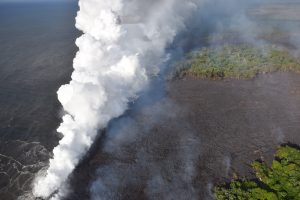Washington, May 21 (EFE).- A cloud of toxic vapor continued to rise into the sky above the island of Hawaii on Monday while rivers of lava from the Kilauea volcano reached the Pacific Ocean, creating a new danger for the local population after the fire mountain’s eruption two weeks ago.
Hawaii County Civil Defense, which has been administering the island where the volcano is located, warned that the arrival of the red-hot lava at the shore – creating a potentially toxic thick steam – could contaminate the air with a substance known as “laze,” a combination of the words “lava” and “haze.”

The phenomenon, forming a white cloud, sends fine particles of glass and other matter into the air along with hydrochloric acid and the wind can carry these dangerous substances over populated areas causing irritation of the lungs, eyes and skin, the island’s Civil Defense authorities said on their Web site.
Since Kilauea began erupting on May 3, more than 1,700 people have had to be evacuated and some 40 structures, dozens of homes and automobiles have been destroyed by lava flows.
On Friday and Saturday, the volcano registered a new explosion which, despite its short duration, created an ash cloud more than 3,000 meters (some 10,000 feet) high.
The US Geological Survey’s Hawaiian Volcano Observatory warned on Saturday that it is possible that additional explosions could occur at any time, producing small ashfalls that could be displaced by the wind.
In recent hours, the USGS reported that moderate lava emissions continue at multiple points and asked the public to take precautions because, due to the wind, the air could become contaminated in some spots with gas and fine particles of silica.
The volcano’s activity resulted in the first serious injury on Saturday, when a burst – or splash – of lava hit and broke the leg of a man on a third-floor balcony.
Kilauea is located in the southeastern portion of the island of Hawaii, the largest in the archipelago, where some 185,000 people live.
